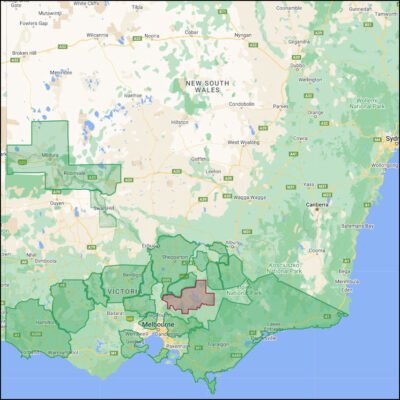The Upper Goulburn wine region forms part of Victoria’s Central Victoria wine zone alongside Bendigo, Heathcote, Strathbogie Ranges, and Goulburn Valley, a picturesque two-and-a-half-hour drive from Melbourne. Lake Eildon, one of Victoria’s most important water sources, is in the eastern half of the region, and the Goulburn River runs east to west through its centre.
The region is one of Victoria’s hidden gems, located at the foothills of the Great Dividing Range. Known for its high-altitude vineyards and cool climate, it produces elegant and refined wines.
It is one of the few Victorian regions without a history of nineteenth-century viticulture, as it may have been deemed too cold. The wine industry only began to take shape in the late 1960s, when the first vines were planted and were accorded GI (Geographic Indication) status in 2003.
Upper Goulburn benefits from its high-altitude vineyards, which range from 250 to over 800 meters above sea level. This elevation, combined with the region’s proximity to the Goulburn River and the cool breezes from the nearby mountains, creates ideal conditions for slow grape ripening. The region’s climate is characterized by cool, wet winters and warm summers, with significant daily temperature ranges that help preserve acidity and enhance the aromatic complexity of the wines.
The soils in Upper Goulburn are diverse, ranging from sandy loams to volcanic clay, which provides excellent drainage and minerality to the wines. These natural advantages make Upper Goulburn a key player in Australia’s cool-climate wine scene.
Top Stats
Harvest
Late Mar to late May
Mean Jan temperature
19.9°C
Area of Vine
289 hectares
Altitude
140 – 1777m
Growing season rainfall
434mm
Principal Varietals
Upper Goulburn is celebrated for producing a range of cool-climate varietals, each showcasing the region’s unique terroir. The split of red to white is reasonably even.
Chardonnay from the region is crisp and vibrant, characterized by high natural acidity with flavours of citrus, green apple, and minerality, often enhanced by oak ageing for added complexity. Shiraz, which thrives in the warmer, lower parts of the region, is spicy and elegant. Pinot Noir excels in this cool climate, offering delicate red fruit flavours, earthiness, and a well-structured palate, benefiting from the region’s warm days and cool nights. Cabernet Sauvignon, grown in warmer areas, presents rich black fruit flavours, balanced with fine tannins and subtle oak nuances. Sauvignon Blanc is fresh and zesty, with tropical and herbaceous notes, while Riesling is bright and aromatic, known for its zesty acidity and citrus characteristics, with great ageing potential.
Source: www.wineaustralia.com









